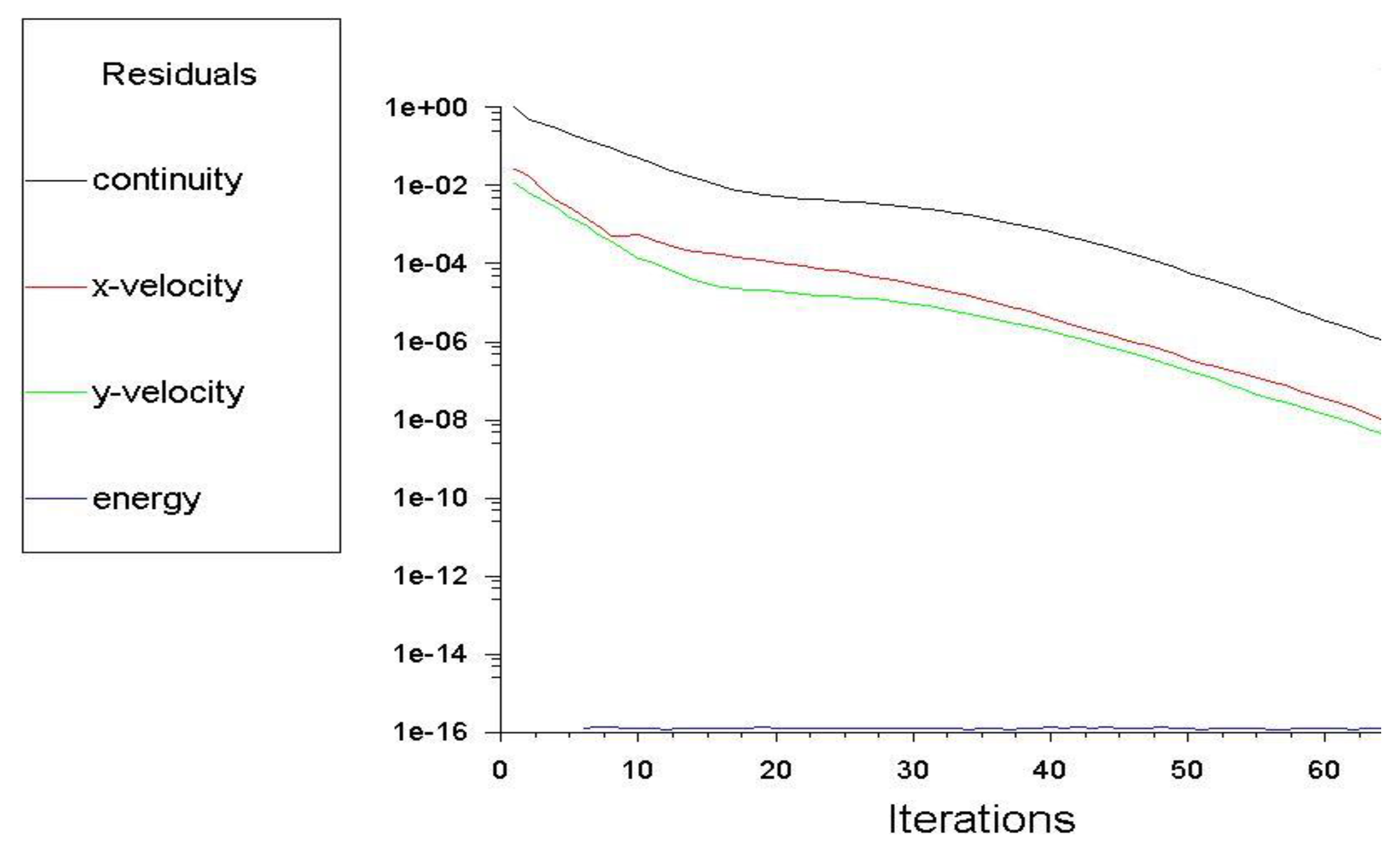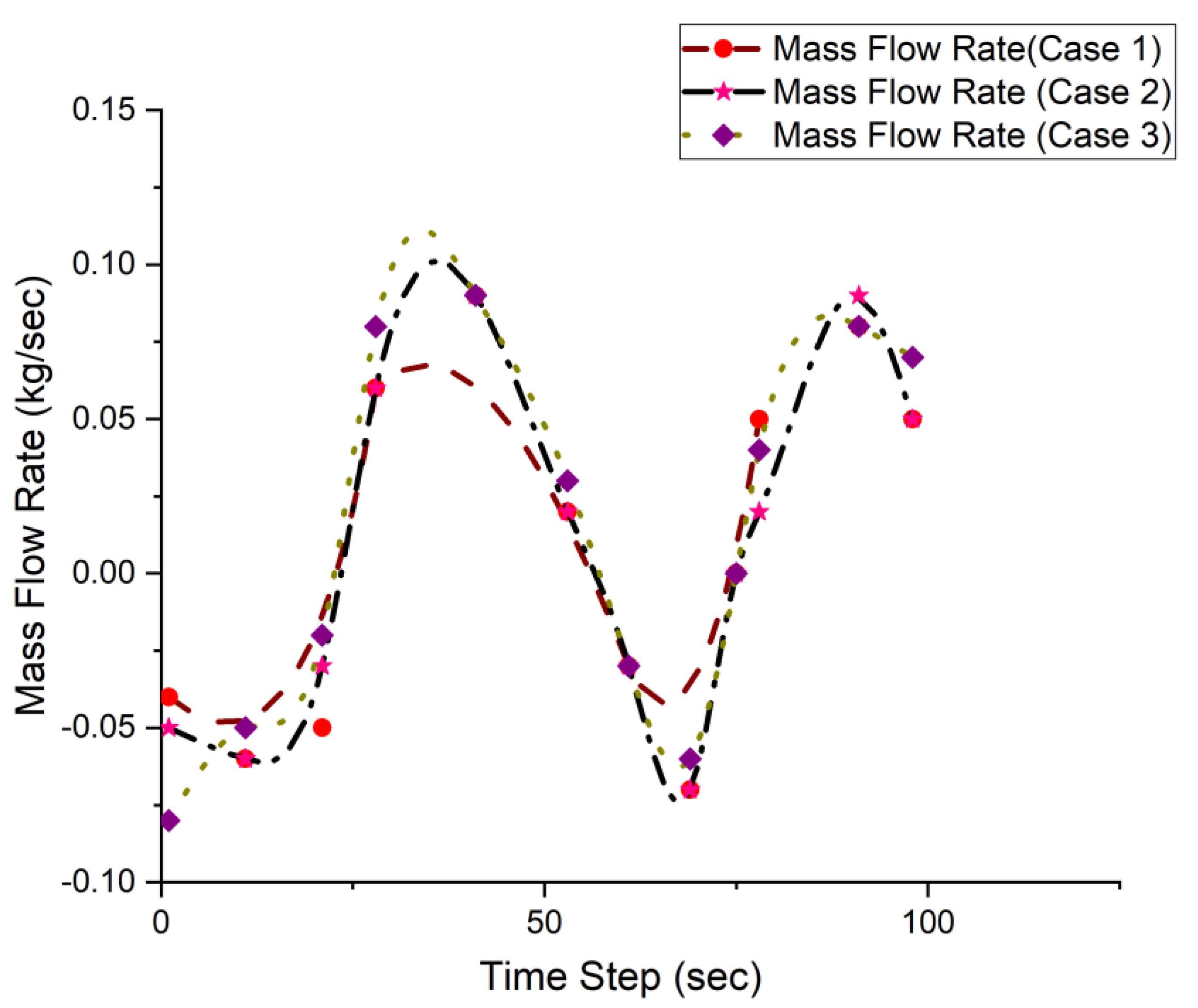Impact of Varying Load Conditions and Cooling Energy Comparison of a Double-Inlet Pulse Tube Refrigerator
Abstract
:1. Introduction
2. Materials and Methods
2.1. Geometry of GM-Type DIPTR
2.2. Grid Independence Test of DIPTR
3. Results and Discussion
3.1. Effect of Phase Relation on Pressure and Mass Flow Rate for DIPTR
3.2. Effect of DI Valve Opening for Different Cases
3.3. Effect of Cold-end Temperature and Time Step for Different Cases
3.4. Effect of Mass Flow Rate and Time Step for Different Cases
3.5. Effect of Distribution of Average Temperaturealong Length of Pulse Tube
3.6. Heat Transfer Rate of CHX for Different Cases
4. Validation of Results
4.1. Cooling Behavior
4.2. Cooling Energy
4.3. Pulse Tube Length
4.4. Regenerator Pressure Inlet
5. Conclusions
Author Contributions
Funding
Conflicts of Interest
References
- Kumar, P.; Gupta, A.K.; Kumar, M.; Sahoo, R.K. Numerical investigation to predict the performance of a GM pulse tube refrigerator using of pressure wave profile GM pulse tube refrigerator. Mater. Sci. 2018, 6, 1–7. [Google Scholar]
- Gujarati, P.B.; Desai, K.P.; Naik, H.B.; Atrey, M.D. Transient analysis of single stage GM type double inlet pulse tube cryocooler. In IOP Conference Series: Materials Science and Engineering; no. 1; IOP Publishing: Bristol, UK, 2015; Volume 101, p. 012033. [Google Scholar]
- Kumar, P.; Gupta, A.K.; Sahoo, R.K.; Jena, D.P. Numerical investigation of a 3D inertance pulse tube refrigerator from design prospective. Cryogenics 2019, 98, 125–138. [Google Scholar] [CrossRef]
- Wang, W.; Hu, J.; Xu, J.; Zhang, L.; Luo, E. Influence of the water-cooled heat exchanger on the performance of a pulse tube refrigerator. Appl. Sci. 2017, 7, 229. [Google Scholar] [CrossRef] [Green Version]
- Liu, X.; Chen, C.; Huang, Q.; Wang, S.; Hou, Y.; Chen, L. Modeling of heat transfer and oscillating flow in the regenerator of a pulse tube cryocooler operating at 50 Hz. Appl. Sci. 2017, 7, 553. [Google Scholar] [CrossRef] [Green Version]
- Hamood, A.; Jaworski, A.J.; Mao, X. Development and assessment of two-stage thermoacoustic electricity generator. Energies 2019, 12, 1790. [Google Scholar] [CrossRef] [Green Version]
- Roy, P.C.; Kundu, B. Thermodynamic modeling of a pulse tube refrigeration system. J. Therm. Eng. 2018, 4, 1668–1679. [Google Scholar] [CrossRef]
- Tang, K.; Feng, Y.; Jin, T.; Jin, S.; Yang, R. Impact of Gedeon streaming on the efficiency of a double-inlet pulse tube refrigerator. Appl. Therm. Eng. 2017, 111, 445–454. [Google Scholar] [CrossRef]
- Antao, D.S.; Farouk, B. Computational fluid dynamics simulations of an orifice type pulse tube refrigerator: Effects of operating frequency. Cryogenics 2011, 51, 192–201. [Google Scholar] [CrossRef]
- Liu, D.; Dietrich, M.; Thummes, G.; Gan, Z. Numerical simulation of a GM-type pulse tube cryocooler system: Part II. Rotary valve and cold head. Cryogenics 2017, 81, 100–106. [Google Scholar] [CrossRef]
- Kim, K.; Zhi, X.; Qiu, L.; Nie, H.; Wang, J. Analyse numérique des différents effets des vannes sur les performances de refroidissement d’un refroidisseur cryogénique à tube à pulsation de type Gifford-McMahon à deux étages. Int. J. Refrig. 2017, 77, 1–10. [Google Scholar] [CrossRef]
- Ashwin, T.R.; Narasimham, G.S.V.L.; Jacob, S. CFD analysis of high frequency miniature pulse tube refrigerators for space applications with thermal non-equilibrium model. Appl. Therm. Eng. 2010, 30, 152–166. [Google Scholar] [CrossRef] [Green Version]
- Zhu, S.W.; Chen, Z.Q. Isothermal model of pulse tube refrigerator. Cryogenics 1994, 34, 591–595. [Google Scholar] [CrossRef]
- Moldenhauer, S.; Thess, A.; Holtmann, C.; Fernández-Aballí, C. Thermodynamic analysis of a pulse tube engine. Energy Convers. Manag. 2013, 65, 810–818. [Google Scholar] [CrossRef]
- Yang, S.; Wu, Y.N.; Zhou, Z.P.; Jiang, Z.H.; Zhang, A.K. Simulation and Experimental Analysis of Pulse Tube Refrigerator with an Active Phase Controller; International Cryocooler Conference, Inc.: Boulder, CO, USA, 2016; pp. 211–218. [Google Scholar]
- Dang, H.; Zhao, Y. CFD modeling and experimental verification of a single-stage coaxial Stirling-type pulse tube cryocooler without either double-inlet or multi-bypass operating at 30–35 K using mixed stainless steel mesh regenerator matrices. Cryogenics 2016, 78, 40–50. [Google Scholar] [CrossRef]
- Yu, H.; Wu, Y.; Ding, L.; Jiang, Z.; Liu, S. An efficient miniature 120 Hz pulse tube cryocooler using high porosity regenerator material. Cryogenics 2017, 88, 22–28. [Google Scholar] [CrossRef]
- Arunkumar, K.N.; Kasthuriregan, S.; Vasudevan, K. Numerical analysis of single stage pulse tube refrigerator. Int. J. Eng. Technol. 2017, 9, 3798–3805. [Google Scholar]
- Abraham, D.; Damu, C.; Kuzhiveli, B.T. Numerical analysis of inertance pulse tube cryocooler with a modified reservoir. IOP Conf. Ser. Mater. Sci. Eng. 2017, 278, 012154-62, No. 1. [Google Scholar] [CrossRef] [Green Version]
- Gour, A.S.; Sagar, P.; Karunanithi, R. Design, development and testing twin pulse tube cryocooler. Cryogenics 2017, 86, 87–96. [Google Scholar] [CrossRef]
- Cao, Y.; Chen, X.; Wu, Y. Theoretical and experimental investigation of two pulse tube cryocoolers driven by a single opposed linear compressor. Cryogenics 2014, 61, 154–157. [Google Scholar] [CrossRef]
- Gifford, W.E.; Longsworth, R.C. Pulse-Tube Refrigeration. ASME. J. Eng. Ind. 1964, 86, 264–268. [Google Scholar] [CrossRef]
- Krishnappa, G.B.; Madhu, D.; Kasthurirengan, S. Comparison of 1D and 2D flow numerical analysis applied to two stage pulse tube cryocooler. In AIP Conference Proceedings; No. 1; American Institute of Physics: College Park, MD, USA, 2012; Volume 1434, pp. 1157–1164. [Google Scholar]
- Liu, S.; Chen, X.; Zhang, A.; Kan, A.; Zhang, H.; Wu, Y. Impact of coiled type inertance tube on performance of pulse tube refrigerator. Appl. Therm. Eng. 2016, 107, 63–69. [Google Scholar] [CrossRef]
- Antao, D.S.; Farouk, B. Experimental and numerical investigations of an orifice type cryogenic pulse tube refrigerator. Appl. Therm. Eng. 2013, 50, 112–123. [Google Scholar] [CrossRef]
- Rout, S.K.; Behura, A.K.; Dalai, S.; Sahoo, R.K. Numerical analysis of a modified type pulse tube refrigerator. Energy Procedia 2017, 109, 456–462. [Google Scholar] [CrossRef]
- Sosso, A.; Durandetto, P. Experimental analysis of the thermal behavior of a GM cryocooler based on linear system theory. Int. J. Refrig. 2018, 92, 125–132. [Google Scholar] [CrossRef]
- Cai, J.H.; Zhou, Y.; Wang, J.J.; Zhu, W.X. Experimental analysis of double-inlet principle in pulse tube refrigerators. Cryogenics 1993, 33, 522–525. [Google Scholar] [CrossRef]
- Dai, Q.; Chen, Y.; Yang, L. CFD investigation on characteristics of oscillating flow and heat transfer in 3D pulse tube. Int. J. Heat Mass Transf. 2015, 84, 401–408. [Google Scholar] [CrossRef]
- Rout, S.K.; Gupta, A.K.; Choudhury, B.K.; Sahoo, R.K.; Sarangi, S.K. Influence of porosity on the performance of a pulse tube refrigerator: A CFD study. Procedia Eng. 2013, 51, 609–616. [Google Scholar] [CrossRef] [Green Version]
- Banjare, Y.P.; Sahoo, R.K.; Sarangi, S.K. CFD simulation of a Gifford-McMahon type pulse tube refrigerator. Int. J. Therm. Sci. 2009, 48, 2280–2287. [Google Scholar] [CrossRef]
- Biswas, A.; Ghosh, S.K. Experimental and numerical investigation on performance of a double-inlet type cryogenic pulse tube refrigerator. Heat Mass Transf. Stoffuebertragung 2016, 52, 1899–1908. [Google Scholar] [CrossRef]
- Das, P.C.; Roy, S.K.; Sarangi, P.K. Some Theoretical and Experimental Studies on Pulse Tube Refrigeration; IIT: Kharagpur, India, 2004. [Google Scholar]
- Banjare, Y.P.; Sahoo, R.K.; Sarangi, S.K. CFD simulation and experimental validation of a GM-type double-inlet pulse tube refrigerator. Cryogenics 2010, 50, 271–280. [Google Scholar] [CrossRef]















| Study Case | Case 1 | Case 2 | Case 3 | Case 4 | Case 5 |
|---|---|---|---|---|---|
| Inlet pipe wall | 293 K | 293 K | 293 K | 293 K | 293 K |
| After cooler wall | 293 K | 293 K | 293 K | 293 K | 293 K |
| Regenerator wall | Adiabatic | Adiabatic | Adiabatic | Adiabatic | Adiabatic |
| Cold-end heat exchanger wall | Adiabatic | Adiabatic | Adiabatic | Heat flux 1 W | 150 K |
| Pulse tube wall | Adiabatic | Adiabatic | Adiabatic | Adiabatic | Adiabatic |
| Hot-end heat exchanger wall | 293 K | 293 K | 293 K | 293 K | 293 K |
| Orifice tube wall | 290 K | 290 K | 290 K | 290 K | 290 K |
| Surge volume wall | 295 K | 295 K | 295 K | 295 K | 295 K |
| Initial conditions | 293 K | 293 K | 293 K | 293 K | 293 K |
| Cold-end load | 0 W | 0 W | 0 W* | 1 W | 3.7 W* |
| Cold-end temp | 150 K* | 155 K* | 200 K* | 130 K* | 155 K |
| Cases | Valve Opening of Double-inlet | Opening of Orifice Valve | Boundary Condition Cold-end |
|---|---|---|---|
| Case #1 | 20.0% | 30.0% | 0 W |
| Case #2 | 20.0% | 40.0% | 0 W |
| Case #3 | 20.0% | 60.0% | 1 W |
| Case #4 | 20.0% | 30.0% | 130 K |
| Case #5 | 20.0% | 30.0% | 5.0 W |
© 2020 by the authors. Licensee MDPI, Basel, Switzerland. This article is an open access article distributed under the terms and conditions of the Creative Commons Attribution (CC BY) license (http://creativecommons.org/licenses/by/4.0/).
Share and Cite
Arslan, M.; Farooq, M.; Naqvi, M.; Sultan, U.; Tahir, Z.-u.-R.; Nawaz, S.; Waheed, N.; Naqvi, S.R.; Ali, Q.; Tariq, M.S.; et al. Impact of Varying Load Conditions and Cooling Energy Comparison of a Double-Inlet Pulse Tube Refrigerator. Processes 2020, 8, 352. https://doi.org/10.3390/pr8030352
Arslan M, Farooq M, Naqvi M, Sultan U, Tahir Z-u-R, Nawaz S, Waheed N, Naqvi SR, Ali Q, Tariq MS, et al. Impact of Varying Load Conditions and Cooling Energy Comparison of a Double-Inlet Pulse Tube Refrigerator. Processes. 2020; 8(3):352. https://doi.org/10.3390/pr8030352
Chicago/Turabian StyleArslan, Muhammad, Muhammad Farooq, Muhamamd Naqvi, Umair Sultan, Zia-ur-Rehman Tahir, Saad Nawaz, Nazim Waheed, Salman Raza Naqvi, Qasim Ali, M. Suleman Tariq, and et al. 2020. "Impact of Varying Load Conditions and Cooling Energy Comparison of a Double-Inlet Pulse Tube Refrigerator" Processes 8, no. 3: 352. https://doi.org/10.3390/pr8030352








